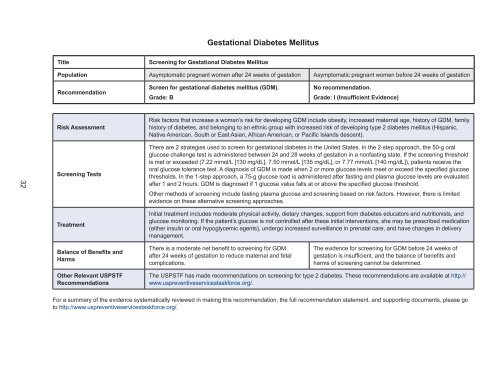1DpwC8F
1DpwC8F
1DpwC8F
You also want an ePaper? Increase the reach of your titles
YUMPU automatically turns print PDFs into web optimized ePapers that Google loves.
Gestational Diabetes Mellitus<br />
Title<br />
Screening for Gestational Diabetes Mellitus<br />
Population Asymptomatic pregnant women after 24 weeks of gestation Asymptomatic pregnant women before 24 weeks of gestation<br />
Recommendation<br />
Screen for gestational diabetes mellitus (GDM).<br />
Grade: B<br />
No recommendation.<br />
Grade: I (Insufficient Evidence)<br />
Risk Assessment<br />
Risk factors that increase a woman’s risk for developing GDM include obesity, increased maternal age, history of GDM, family<br />
history of diabetes, and belonging to an ethnic group with increased risk of developing type 2 diabetes mellitus (Hispanic,<br />
Native American, South or East Asian, African American, or Pacific Islands descent).<br />
32<br />
Screening Tests<br />
There are 2 strategies used to screen for gestational diabetes in the United States. In the 2-step approach, the 50-g oral<br />
glucose challenge test is administered between 24 and 28 weeks of gestation in a nonfasting state. If the screening threshold<br />
is met or exceeded (7.22 mmol/L [130 mg/dL], 7.50 mmol/L [135 mg/dL], or 7.77 mmol/L [140 mg/dL]), patients receive the<br />
oral glucose tolerance test. A diagnosis of GDM is made when 2 or more glucose levels meet or exceed the specified glucose<br />
thresholds. In the 1-step approach, a 75-g glucose load is administered after fasting and plasma glucose levels are evaluated<br />
after 1 and 2 hours. GDM is diagnosed if 1 glucose value falls at or above the specified glucose threshold.<br />
Other methods of screening include fasting plasma glucose and screening based on risk factors. However, there is limited<br />
evidence on these alternative screening approaches.<br />
Treatment<br />
Initial treatment includes moderate physical activity, dietary changes, support from diabetes educators and nutritionists, and<br />
glucose monitoring. If the patient’s glucose is not controlled after these initial interventions, she may be prescribed medication<br />
(either insulin or oral hypoglycemic agents), undergo increased surveillance in prenatal care, and have changes in delivery<br />
management.<br />
Balance of Benefits and<br />
Harms<br />
There is a moderate net benefit to screening for GDM<br />
after 24 weeks of gestation to reduce maternal and fetal<br />
complications.<br />
The evidence for screening for GDM before 24 weeks of<br />
gestation is insufficient, and the balance of benefits and<br />
harms of screening cannot be determined.<br />
Other Relevant USPSTF<br />
Recommendations<br />
The USPSTF has made recommendations on screening for type 2 diabetes. These recommendations are available at http://<br />
www.uspreventiveservicestaskforce.org/.<br />
For a summary of the evidence systematically reviewed in making this recommendation, the full recommendation statement, and supporting documents, please go<br />
to http://www.uspreventiveservicestaskforce.org/.


